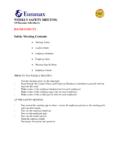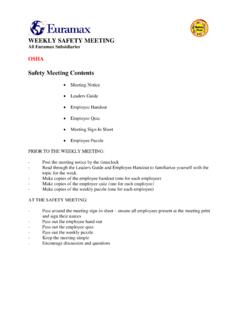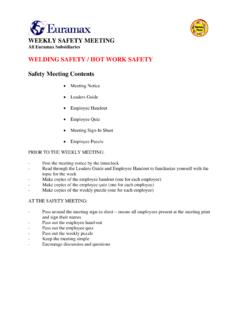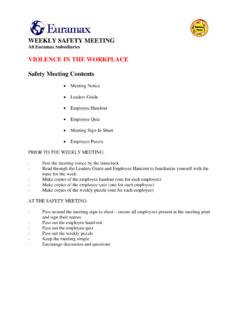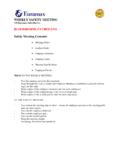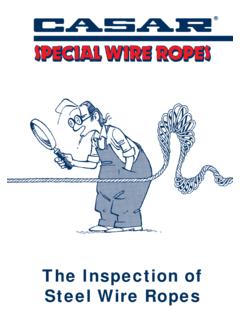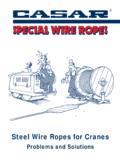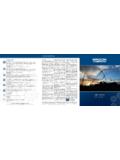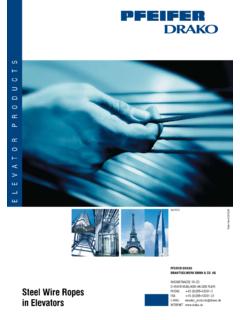Transcription of WEEKLY SAFETY MEETING ROPES, CHAINS AND …
1 WEEKLY SAFETY MEETING All Euramax Subsidiaries ROPES, CHAINS AND SLINGS SAFETY MEETING Contents MEETING Notice Leaders Guide Employee Handout Employee Quiz MEETING Sign-In Sheet Employee Puzzle PRIOR TO THE WEEKLY MEETING : - Post the MEETING notice by the timeclock - Read through the Leaders Guide and Employee Handout to familiarize yourself with the topic for the week - Make copies of the employee handout (one for each employee) - Make copies of the employee quiz (one for each employee) - Make copies of the WEEKLY puzzle (one for each employee) AT THE SAFETY MEETING : - Pass around the MEETING sign-in sheet ensure all employees present at the MEETING print and sign their names - Pass out the employee hand-out - Pass out the employee quiz - Pass out the WEEKLY puzzle - Keep the MEETING simple - Encourage discussion and questions WEEKLY SAFETY MEETING NOTICE THIS WEEK, OUR SAFETY MEETING WILL COVER ROPES, CHAINS , AND SLINGS TIME: _____ DATE: _____ PLACE: _____ WEEKLY SAFETY MEETING All Euramax Subsidiaries Leaders Guide Page 1 ROPES, CHAINS , AND SLINGS EURAMAX PROCEDURE REFERENCE: Hoisting Equipment MEETING OBJECTIVE.
2 The use of ropes, CHAINS , and slings in the workplace poses special SAFETY problems. Many accidents occur because employees are unaware of indifferent to load limitations and proper inspection and care procedures for this equipment. The purpose of this MEETING is to teach employees to work safely with and around these useful pieces of equipment. MEETING PREPARATION: Read the Euramax procedure, understand the contents, and ensure compliance. Gather samples of new and worn fiber ropes, wire ropes, and CHAINS (if applicable). Review the employee handout to see if there are any other materials you wish to bring to the MEETING . Use a flip chart during the discussion to write key points and employee responses.
3 This technique visually reinforces your instruction. MATERIALS CHECKLIST: Samples of new and worn fiber ropes, wire ropes, and CHAINS Flip chart and marking pens MEETING INTRODUCTION What you don t know about ropes, CHAINS , and slings could hurt you. Today we re going to discuss these items what they re made of and how to take care of them, so that they work the way we expect them to work. In addition, we re going to talk about SAFETY procedures when working with or around ropes, CHAINS , and slings. Here are a couple of definitions related to ropes: Fiber rope : Ropes are made of natural or synthetic fibers. Both types have their advantages and disadvantages. Synthetic fiber ropes are more popular because there s more of a variety to choose from for particular jobs and they re easier to splice.
4 Nylon (synthetic) rope has 2 times the breaking strength of Manila (fiber) rope and about four (4) times it s working elasticity. WEEKLY SAFETY MEETING All Euramax Subsidiaries Leaders Guide Page 2 ROPES, CHAINS , AND SLINGS wire rope : wire rope is made of steel wires, strands, and core. It is frequently used instead of fiber rope because it is stronger and more durable and its physical characteristics don t change in different environments. In addition, wire rope s stretch characteristics are more predictable. DISCUSSION GUIDE Explain that during this MEETING you will be talking about fiber rope , wire rope , fiber and wire rope slings, and CHAINS and chain slings. FIBER rope Display samples of new and worn fiber ropes. Explain the factors to consider when choosing a rope : Rot resistance Strength Stretch with load Recovery from stretch Floatability Water repellency Temperature resistance Chemical resistance Sunlight resistance Friction melting Remind employees to consult their supervisor when choosing a rope for a particular job.
5 Usage charts indicating working load capacity are tabulated for rope in top-notch condition with appropriate splices in noncritical applications. They re generally rated for static, not dynamic, loads. When a load is swung, picked up, stopped quickly, or moved in any way, there is an increase force exerted on the rope . Therefore, the working load capacity needs are increased. Discuss the different types of ropes used at your facility and their appropriate applications. WEEKLY SAFETY MEETING All Euramax Subsidiaries Leaders Guide Page 3 ROPES, CHAINS , AND SLINGS Question: What types of accidents do you think could happen when ropes are used improperly? Answer: A heavy load suspended above one or more workers could fall and the workers could be seriously injured.
6 Prevent this by keeping the area below a raised load clear of employees. Employees can also be injured by the whiplash of a broken line. Question: What do you look for when you inspect a new rope ? Answer: (Demonstrate) Check the entire length of the rope for damage or defects before using it. Question: What do you look for when you inspect an in-service rope ? Answer: (Demonstrate) Ropes used under normal conditions should be inspected every 30 days. Ropes used for critical operations, such as supporting scaffolding, should be inspected more often. Check the entire length of the rope Abrasions, wear Broken or cut fibers Displacement of yarns or strands Rotting, discoloration Question: How do you inspect a rope ?
7 Answer: The inter fibers can be inspected by untwisting the rope in several places to see whether the inner yarns are clear and bright. Replace a fiber rope that has been exposed to acids. Visual inspection might not reveal deterioration. Tell employees to use the fingernail test for detecting deterioration in fiber ropes. Scratch inner fibers with fingernail. If fibers part easily there has been too much wear. If fiber rope has been loaded to more than 50 percent of its breaking strength, it will be damaged and must be replaced. WEEKLY SAFETY MEETING All Euramax Subsidiaries Leaders Guide Page 4 ROPES, CHAINS , AND SLINGS Question: What steps can we all take to prevent too much wear and tear on ropes used at the facility?
8 Answer: Never drag a rope . This hurts the outer fibers and leads to the eventual deterioration of the ropes overall strength. Avoid kinking. This strains the rope and overstresses the fibers. Splice, don t knot. When the job requires joining lengths of ropes, they should be spliced, not knotted. A properly done splice will hold up to 100 percent of the strength of the rope , a knot only half. Dry out rope after use to prevent deterioration. Don t allow rope to freeze. Store away from heat, moisture, chemicals, rodents, sunlight. Never store rope in areas containing acid or acid vapors. Dark brown or black spots will develop, indicating rope deterioration. Clean rope before storage. Demonstrate the proper way to coil a rope to prevent kinking.
9 Set the rope coil on the ground with the bottom end down. Pull the bottom end up through the coil, and unwind the rope counterclockwise. If it uncoils in the other direction, you ll have to turn the coil of rope over and pull the end out on the other side. wire rope Question: What are some of the signs that wire rope is damaged? Answer: Look for any break or movement in the strands that make up the rope . For example: Kinks wire breaks in the valleys of strands bird cages Square breaks in the crown of the strands WEEKLY SAFETY MEETING All Euramax Subsidiaries Leaders Guide Page 5 ROPES, CHAINS , AND SLINGS Question: What are some causes of damage and deterioration? Answer: Corrosion, wear, kinks, fatigue, drying out, overloading, and overwinding Question: What can we do to improve the SAFETY and efficiency of wire ropes?
10 Answer: Use sheaves and drums of suitable size and design. Lubricate properly, according to schedule Maintain rope and hoisting equipment. Don t exceed the rated capacity or wire rope . Be sure to use the correct lay (twist) for the application. Report and replace defective wire rope . FIBER AND wire rope SLINGS Question: What points should you consider when using a fiber or wire rope sling? Answer: Capacity Method of fastening rope to the fitting, type of sling (single or three-legged) Type of hitch Remind employees that all rules for regular maintenance and inspection of ropes apply to slings, as well. Question: If a load has sharp edges, what precautions must be taken and why? Answer: To prevent breakage, pads or saddles should be used.
